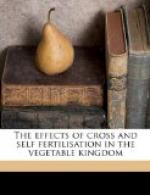Seedlings from a crimson English variety crossed by a pale-coloured variety which had been grown for some generations in Algiers, were to the self-fertilised seedlings from the crimson variety in height as 100 to 89, and as 100 to 75 in fertility. I am surprised that this cross with another variety did not produce a still more strongly marked beneficial effect; for some intercrossed plants of the crimson English variety, put into competition with plants of the same variety self-fertilised during three generations, were in height as 100 to 86, and in fertility as 100 to 75. The slightly greater difference in height in this latter case, may possibly be attributed to the deteriorating effects of self-fertilisation carried on for two additional generations.
5. Eschscholtzia californica.
This plant offers an almost unique case, inasmuch as the good effects of a cross are confined to the reproductive system. Intercrossed and self-fertilised plants of the English stock did not differ in height (nor in weight, as far as was ascertained) in any constant manner; the self-fertilised plants usually having the advantage. So it was with the offspring of plants of the Brazilian stock, tried in the same manner. The parent-plants, however, of the English stock produced many more seeds when fertilised with pollen from another plant than when self-fertilised; and in Brazil the parent-plants were absolutely sterile unless they were fertilised with pollen from another plant. Intercrossed seedlings, raised in England from the Brazilian stock, compared with self-fertilised seedlings of the corresponding second generation, yielded seeds in number as 100 to 89; both lots of plants being left freely exposed to the visits of insects. If we now turn to the effects of crossing plants of the Brazilian stock with pollen from the English stock,—so that plants which had been long exposed to very different conditions were intercrossed,—we find that the offspring were, as before, inferior in height and weight to the plants of the Brazilian stock after two generations of self-fertilisation, but were superior to them in the most marked manner in the number of seeds produced, namely, as 100 to 40; both lots of plants being left freely exposed to the visits of insects.
In the case of Ipomoea, we have seen that the plants derived from a cross with a fresh stock were superior in height as 100 to 78, and in fertility as 100 to 51, to the plants of the old stock, although these had been intercrossed during the last ten generations. With Eschscholtzia we have a nearly parallel case, but only as far as fertility is concerned, for the plants derived from a cross with a fresh stock were superior in fertility in the ratio of 100 to 45 to the Brazilian plants, which had been artificially intercrossed in England for the two last generations, and which must have been naturally intercrossed by insects during all previous generations in Brazil, where otherwise they are quite sterile.




